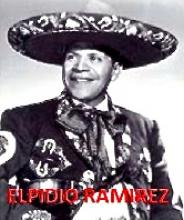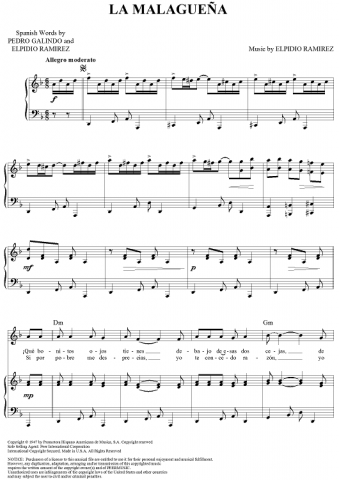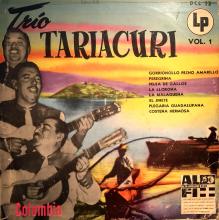Recently, an observant music fan noticed an error on this site and wrote to tell us about it. His concern is related to one of the most famous and recognizable compositions in the Latin American songbook, entitled “Malagueña” or “La Malagueña.”
 Roberto García Cepeda
Roberto García Cepeda, a Cuban-American music blogger, told us that an RCA Victor recording of the classic song was credited on the site to the wrong composer. He said
“Malagueña,” released by RCA in Mexico on an EP with four other tracks (EP-MKE-93-A-1), was written by famed Cuban composer Ernesto Lecuona. The song, he continued, “has nothing to do with Elpidio Ramírez,” the Mexican songwriter the site lists instead.
García is both right and wrong.

Lecuona is indeed the composer of a song named “Malagueña,” but so is Ramirez. That’s because there are two completely different versions of the song, one written as a semi-classical instrumental for piano and the other a folkloric son huasteco with guitars and vocals. Both are equally famous in their own genres, written two decades apart, each with melodies so familiar they have become cultural touchstones.
One small but important distinction: Lecuona’s Cuban classic is written without the article in Spanish for “the,” so it’s simply “Malagueña.” Ramirez’s equally classic Mexican folk song is titled “La Malagueña,” with the feminine article. Due to a data entry error that will be corrected, the Lecuona recording is listed on the site with the article although the record label itself correctly spells it without.

In either case, “Malagueña” refers to a woman from Málaga, a city and province located in the Andalucía region of southern Spain, known as the cradle of flamenco music and gypsy culture. The legendary beauty of the women from that area is also represented in art, particularly the 1917 portrait “La Malagueña” by the flamenco-influenced painter Julio Romero de Torres, who pictures his subject with a guitar across her lap.
Confusion about the term is understandable because it has multiple meanings. Malagueña refers to two distinct genres, a Venezuelan folk style and a type of flamenco. (The latter is represented in the Frontera Collection in two songs,
“Yo Tenía” and
“Solo y Sin Calor de Nadie,” by La Andalucita.) Malagueña is also the name of classical music pieces by composers Dmitri Shostakovich, Maurice Ravel, and Isaac Albéniz.
Lecuona, nicknamed the “Cuban Gershwin,” wrote his song in the late 1920s as part of a larger, semi-classical piece known as the “Suite Andalucía,” or “Suite Española.” His “Malagueña,” the last of six movements in the suite, has been recorded countless times in various formats from classical guitar to full orchestra.
Lecuona’s work has been interpreted by a wide variety of artists. Pop singer
Connie Francis recorded “Malagueña” with Spanish lyrics, released in 1960 as a B-side to her No. 1 hit “My Heart Has a Mind of Its Own.” (The composer himself added the Spanish lyrics subsequent to writing the song.) In that same decade, pianist
Liberace performed the tune in flashy fashion on a TV show hosted by Sammy Davis Jr. The 1960s also yielded recordings of the song in various styles—among them are a live version by Puerto Rican pop singer and guitarist Jose Feliciano, a big-band jazz version by Stan Kenton, a flamenco guitar version by Carlos Montoya, a pop instrumental released posthumously by Ritchie Valens of “La Bamba” fame, and even a
surf instrumental version by the Trashmen.
Additionally, “Malagueña” is often used for performances by marching bands and ice skating competitions. With its dramatic crescendos and quiet interludes, the song was well suited for the interpretive routines by two California ice-skating champions in separate solo performances – Sasha Cohen and
Kristi Yamaguchi, who used the song for her 1992 Olympic gold medal-winning routine.
The Frontera Collection, with its emphasis on Mexican-American recordings, contains many more versions of the Mexican composition than the Cuban one. Still, Lecuona’s RCA recording, which features the composer on piano, is one of five versions found in
a search by his name. One notable rendition (also on RCA) by
Irving Fields, a New York Jewish musician famous for his forays into Latin music, features interesting piano improvisations. But perhaps the most collectible copy of Lecuona’s song is a 45-rpm single on
Cuba’s famous Panart label, a powerhouse independent of the pre-Castro era. The song is performed not by a Cuban artist, but by the Orquesta Falcon, part of another famous independent label, the legendary Falcon Records of McAllen Texas. The Falcon orchestra jazzes up the song with a snappy swing style arrangement, exporting it back to Cuba with a Tex-Mex twist.

Though less popular with North American audiences, the Mexican “Malagueña” is an instantly recognizable standard throughout the Latin American world. The opening strains of its stirring introduction are as familiar to Mexican audiences as the opening notes of Beethoven’s Fifth Symphony. In 2004, the Mexican standard got some pop culture exposure in the U.S. when it was used in the soundtrack to the Quentin Tarantino film
Kill Bill: Volume 2; at the movie premiere it was
performed live with an edgy rock feel by Chingon, a Tex-Mex band led by a fellow film director, Robert Rodriguez.

Sometimes titled “Malagueña Salerosa,” this son huasteco is credited to Ramirez and Pedro Galindo and was published by Peer International in 1947. The song is most often performed with full mariachi or guitar trio, but the Frontera Collection has versions in other styles with some variations in the lyrics.
The standard stanzas open with one of the most famous lines in popular Latin music: “Que bonitos ojos tienes / Debajo de esas dos cejas.” (Romantic in Spanish, the words ring a little ridiculous in translation: “What pretty eyes you have/ Under those two eyebrows.”)
The vocal interpretations are highlighted by extensive use of the falsetto, common to this style of Mexican music. By far the most famous rendition is by ranchera singing star
Miguel Aceves Mejía, known for good reason as “El Rey del Falsete.” On his RCA single (51-7387-A), recorded in Mexico and released in the U.S., the singer is backed by the Mariachi Vargas de Tecalitlan.
Aceves Mejia’s falsetto prowess on the song is also spotlighted in
this video from the 1962 Mexican film
Los Cinco Halcones. Of course, all the women he serenades in the scene have beautiful eyes under their two eyebrows.
The Frontera archives feature
more than three dozen recordings of Mexico’s “La Malagueña.” Following are highlights from the collection – the most unusual, the best, and the worst.
Unusual Versions of “La Malagueña”
If you can overlook the scratchy violin, whiny vocals, and terrible recording, pay attention to the unusual additional lyrics. On this record, the song is credited to only Pedro Galindo, although the publisher officially credits the two composers, music by Ramirez and lyrics by both Galindo and Ramirez. So it’s impossible to know who wrote the extra verses here. Some experts claim the song has roots in folklore of the Huasteca region, and the true writers are unknown.
Here is an early version that has absolutely no resemblance to the popular song other than the title. This may be in fact a primitive folkloric incarnation of the composition, which is uncredited. The recording is from 1908 by a group considered
a precursor to the modern mariachi.
Vocalist Kiauitzin offers a special rendition of the song in Nahuatl, the language of the Aztecs. It’s from a cassette by the artist, with guitar accompaniment and occasional percussive punctuations with castanets and what sounds like shells. The song is again credited to Elpidio Ramirez alone, and without knowing Nahuatl, I can’t say if the indigenous lyrics are a direct translation of the Spanish.
The instrumental dance orchestra of Juan Fernandez offers one of the most unusual arrangements of the song. It’s done as a classic danzón, which highlights the beauty of the melody. The usual songwriters are not credited here; instead composer rights are given to Barcelata-Cortazar, two famous names in Mexican pop music. It’s not clear if they are also being credited for the fine arrangement.
Here’s another folkloric version, this one from Veracruz. It’s somewhat rustic, but the violin and guitar work are striking. Again, the verses are totally different from the familiar ones. One line stands out because for once, unlike most other versions, this “Malagueña” mentions the hometown of the woman of the title: “Si en Málaga tu naciste / Pero aquí te conocí.” (“Yes, you were born in Málaga / But I met you here.”)
Notable Versions of “La Malagueña”
As mentioned, Miguel Aceves Mejía may have the best version recorded by a widely recognized artist. But this version is a pleasant surprise from a relatively unknown singer who also has an impressive falsetto. And it’s on a local Los Angeles label, Discos Corona, with a La Cienega Boulevard address (for you L.A. history buffs). Gutierrez is not as forceful or muscular a singer as Aceves Mejía; his voice is softer and cleaner. But check out the way he notches up the falsetto, at one point jumping an octave within the already high range. He’s backed here by the Mariachi Aguila de Guadalajara with an outstanding arrangement by José Martínez that gives the song a rich texture and nicely tailored touches.

This is a personal favorite, simply because it is the version I heard most as a child. The Trio Tariacuri, with its rootsy, folkloric styles, stood out from most of the trios that were all the rage in the 1940s and ’50s, popular for romantic music with guitars and vocal harmonies. Los Tariacuri sounded grittier, more authentically Mexican, you might say. Their version is more slowly paced than most, but the guitars are bright and brimming with feeling, as are the emotional harmonies. You can hear he difference in style by comparing the more genteel and studied version of the song by
Trio Los Panchos, perhaps the most popular Mexican trio of the day. The Frontera Collection also has an alternate version by the Trio Tariacuri on
Fenix, distributed by the independent Peerless label. On this version, the vocals are softer, the pacing more modulated, the guitars more restrained than the Columbia version. Yet, it still has that trademark Tariacuri sound.
Less Successful Versions of “La Malagueña”
Sanchez is one of Mexico’s most important singer/songwriters, famous for classics such as
“Anillo de Compromiso” and
“La Cama de Piedra.” (He has
dozens of songs in the Frontera Collection.) However, his vocal style is bohemian, despairing and whiskey-soaked, not proud and powerful like many top ranchera singers. On “La Malagueña,” that style just doesn’t cut it, despite the fine recording efforts by top-notch producer José Vaca Flores and arranger Pedro Ramírez Velázquez. The track is from Sanchez’s album of Mexican standards, “Joyas Mexicanas.”
Sometimes singers should simply stick to the genre(s) they are good at. Bobby Butler, known as “El Charro Negro,” gained famed as the leader of the Tex-Mex group Tortilla Factory. (Both Butler and the band have been inducted into the Tejano Music Hall of Fame.) But the “Black Charro” doesn’t have the chops for the challenging Mexican “Malagueña,” which requires a vocal character as strong as mescal. Here, Butler sounds bland and his falsetto falls flat, more of a yelp than a howl. He is backed on this album version by Mariachi Alma Jalisciense.
This sounds exactly like the previous song by Bobby Butler although it’s listed as a single by Little Joe and the Latinaires, one of the most famous and long-lived Tejano bands. However, I don’t hear Little Joe’s band here at all, just the mariachi. Since it’s on the same label, my guess is that it’s the same song as the one above from the 33-rpm album by El Charro Negro. And the same criticism applies. Ironically, on this track, it was the label that made the mistake with the title, spelling it as “La Malagena.” This time, the Frontera database got it right, using the proper spelling, “La Malagueña.”
-Agustín Gurza







"Doo Wop" Gringo Version of Malagueña, Circa1959
by carol Cotton (not verified), 08/17/2021 - 15:316th grade,1959, was the first time I heard Malagueña, all instrumental, and played, I think, by an American rock band. I loved it madly, bought the record and played it non-stop until my mother took it away permanently. I've never heard it since and have been unable to find it online. Any idea?
Suite Andalucía: "Malagueña" . . .
by Light Worker (not verified), 12/01/2020 - 21:28La canción «Malagueña» es el sexto movimiento de la Suite Andalucía (1933) compuesta por Ernesto Lecuona, quien también compuso su letra en español... |
"Malagueña" is a song by Cuban composer Ernesto Lecuona. It was originally the sixth movement of Lecuona's Suite Andalucía, to which he added lyrics in Spanish…
Ernesto Lecuona: Suite Andalucía (1933) https://www.youtube.com/watch?v=ESZur_6aZUM
"La Malagueña" vs. "Malagueña" . . .
by Light Worker (not verified), 12/01/2020 - 21:22No confundir la canción "Malagueña Salerosa" ("La Malagueña") de Pedro Galindo & Elpidio Ramírez con la "Malagueña" de Ernesto Lecuona.
Son dos canciones totalmente diferentes!
https://tinyurl.com/y6gyfxyh
https://www.youtube.com/watch?v=eXt9HKzdI4E
Respuesta a "La Malagueña" en Guitarra
by Agustin Gurza, 10/20/2020 - 22:14Estimada Alexa:
Totalmente de acuerdo contigo acerca del talento del maestro Segovia, y te agradezco la recomendación. Mi artículo no pretende ser una reseña de las mejores versiones de esta bella canción, sino una discusión sobre las dos "Malagueñas" que aparecen en nuestro archivo musical en varias versiones. Desafortunadamente, no tenemos ningún disco de Andrés Segovia incluido, porque la colección se especializa en música regional mexicana. En cambio, yo personalmente tengo casi 20 LPs de Segovia en mi colección privada. Por eso, igual que tu, aprecio el valor de su trabajo.
Gracias por tu mensaje y por compartir tu perspectiva importante sobre nuestra música. Nos ayudas de esa manera a mejorar nuestro sitio.
Atentamente,
Agustín Gurza, Editor, La Colección Frontera
"La Malagueña" en Guitarra
by Alexa (not verified), 10/18/2020 - 11:21Llama la atención que no aparezca en el artículo la interpretación de "Malagueña" en guitarra por el maestro Andrés Segovia. Es uno de los más grandes clásicos que ha sido inspirador para todos los amantes de la guitarra, músicos, y guitarristas famosos, incluyendo a los Rolling Stones .
Malagueña
by Álvaro Ochoa-Serrano, 01/10/2019 - 10:40David Zaizar tiene una mejor interpretación, Agustín.